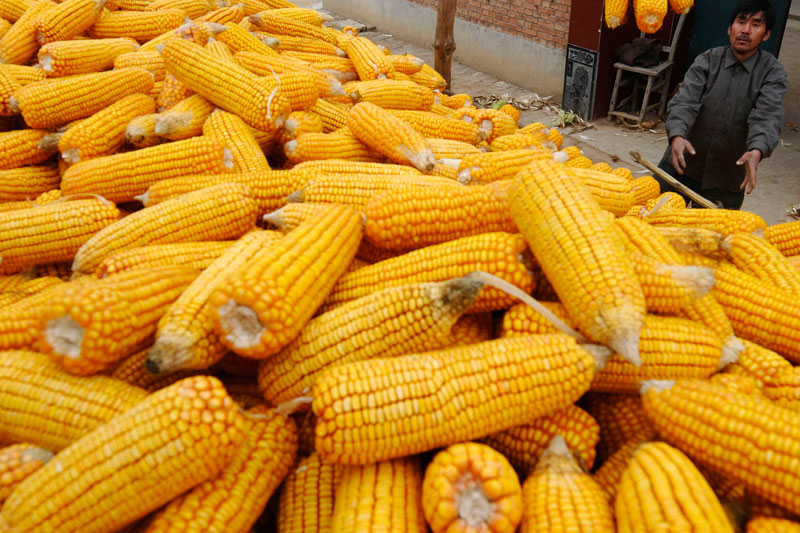Investing.com - U.S. grain futures were little changed on Wednesday, with front-month corn prices steadying after falling sharply in the previous session amid easing concerns over U.S. planting prospects.
On the Chicago Mercantile Exchange, corn futures for July delivery traded at USD6.3925 a bushel, nearly flat on the day. The July contract held in a tight range between USD6.3763 a bushel, the daily low and a session high of USD6.4200 a bushel.
The front-month July corn contract lost nearly 2% on Tuesday to hit USD6.3262 a bushel, the weakest level since May 10, after government data showed U.S. farmers accelerated planting of the nation’s corn crops last week.
According to the U.S. Department of Agriculture, approximately 71% of the U.S. corn crop was planted as of last week, improving significantly from the 28% planted in the preceding week.
Corn prices remain vulnerable to additional losses as favorable weather conditions were expected to further aid U.S. farmers to accelerate planting in the world’s largest grower.
Meanwhile, soybeans futures for July delivery traded at USD14.7538 a bushel, down 0.2% on the day.
The July contract held in a range between USD14.7088 a bushel, the daily low and a session high of USD14.8163 a bushel, the strongest level since March 11.
The USDA said that 24% of the U.S. soy crop was planted as of last week, up sharply from the 6% recorded in the preceding week.
Elsewhere on the CBOT, wheat for July delivery traded at USD6.8413 a bushel, up 0.4% on the day. The July contract was trapped in tight range between USD6.8013 a bushel, the daily low and a session high of USD6.8413 a bushel.
Wheat prices fell to a seven-week low of USD6.7412 a bushel on Tuesday, amid easing concerns over global supplies of the grain.
Updated weather forecasts continued to point to improved weather for developing crops in the Black Sea region.
Last week the USDA said that global wheat inventories at the end of the year will total 186.4 million metric tons, up from the month-earlier estimate of 182.26 million, citing increased production in Russia, Canada and Australia.
Corn is the biggest U.S. crop, followed by soybeans, government figures show. Wheat was fourth, behind hay.
On the Chicago Mercantile Exchange, corn futures for July delivery traded at USD6.3925 a bushel, nearly flat on the day. The July contract held in a tight range between USD6.3763 a bushel, the daily low and a session high of USD6.4200 a bushel.
The front-month July corn contract lost nearly 2% on Tuesday to hit USD6.3262 a bushel, the weakest level since May 10, after government data showed U.S. farmers accelerated planting of the nation’s corn crops last week.
According to the U.S. Department of Agriculture, approximately 71% of the U.S. corn crop was planted as of last week, improving significantly from the 28% planted in the preceding week.
Corn prices remain vulnerable to additional losses as favorable weather conditions were expected to further aid U.S. farmers to accelerate planting in the world’s largest grower.
Meanwhile, soybeans futures for July delivery traded at USD14.7538 a bushel, down 0.2% on the day.
The July contract held in a range between USD14.7088 a bushel, the daily low and a session high of USD14.8163 a bushel, the strongest level since March 11.
The USDA said that 24% of the U.S. soy crop was planted as of last week, up sharply from the 6% recorded in the preceding week.
Elsewhere on the CBOT, wheat for July delivery traded at USD6.8413 a bushel, up 0.4% on the day. The July contract was trapped in tight range between USD6.8013 a bushel, the daily low and a session high of USD6.8413 a bushel.
Wheat prices fell to a seven-week low of USD6.7412 a bushel on Tuesday, amid easing concerns over global supplies of the grain.
Updated weather forecasts continued to point to improved weather for developing crops in the Black Sea region.
Last week the USDA said that global wheat inventories at the end of the year will total 186.4 million metric tons, up from the month-earlier estimate of 182.26 million, citing increased production in Russia, Canada and Australia.
Corn is the biggest U.S. crop, followed by soybeans, government figures show. Wheat was fourth, behind hay.
